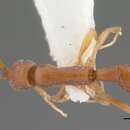en
names in breadcrumbs


(Figs. 8, 10)
Holotype worker: TL 2.4, HL 0.58, HW 0.375 (CI 65), scape L 0.40, WL 0.75, pronotal W 0.29, petiolar node L 0.32, petiolar node W 0.21 mm. Head shaped much as in P. dammermani , P. salomonis , and P. greavesi (Taylor 1965: figs. 17, 20, 22) but posterior border less strongly concave even than in P. greavesi (Taylor, fig. 22). Although the head is narrow, the sides are convex. No eyes detected at 50 X.
Trunk (= Taylor's " mesosoma ") much as in P. salomonis (Taylor, fig. 21), very feebly but evenly convex from front to rear in side-view outline, and propodeal teeth or angles a little better developed, almost rectangular. Petiole as shown in figs. 8 and 10, lateral petiolar index (see Taylor, p. 351) about 136, most like that of P. dammermani , but the dorsal surface convex behind as well as in front; seen from above with almost perfectly straight sides diverging caudad and ending in a pair of acute angles, with the posterior border between broadly and rather deeply concave. In the 3 previously described species, the node is shorter and has distinctly convex sides as seen from above, and the posterodorsal border is rounded (feebly emarginate in the middle in salomonis ) or transverse and nearly straight ( greavesi ).
Postpetiole (first gastric segment, or true abdominal segment III) fairly robust, as in greavesi , but truncate anteriorly.
Maxillary and labial palpi, as much as can be seen of them, as in P. dammermani . Erect pilosity restricted to a few hairs on the mandibles; sculpture-pubescence of the very fine, opaque " pruinose " kind (50 X), overlain by larger punctures of foveoleae that are particularly distinct on the 2 main gastric segments, where the integument is slightly more shining; the sculpture is like that of P. dammermani , except that the larger punctures are a little larger and more distinct on node and gaster. Color medium ferruginous (or " golden-brown " in Taylor's parlance) with more yellowish antennae and legs.
Holotype worker a unique taken by Winkler apparatus (sample no. 20) in the Paini Hills, Madras State, India, 39 km E of Kodaikanal, elevation 650 m, 11 November 1972 by the team of Besuchet, Loebl, and Mussard of MHN — Geneva, in which institution the type is deposited (Forel Collection).
P. procne is named after the mythical woman who was changed into a swallow, and hence the swallow itself, because of the dorsal-view shape of the petiole in the ant. This petiolar form will readily distinguish the species from all others in the genus. The subpetiolar process is like that of P. dammermani and unlike that of P. bidens .
[21] A single worker taken in rain-forest leaf litter berlesate at the Quebrada Susumuko, 1000 m, 23 km NW of Villavicencio, Meta, Colombia (S. and J. Peck, B- 234) is considered to belong to P. petiolatus after direct comparison with the type (Weber Coll., now in MCZ). The new specimen has TL 2.6, HL 0.63, HW 0.39 (CI 62), scape L 0.40 (SI 103), WL 0.83 mm, and the lateral petiolar index of Taylor is about 94 (vs. 85 for the petiolatus type, although I find the node measurements as defined by Taylor somewhat ambiguous). Thus, the Colombian specimen is larger, has a longer, relatively narrower head, and longer scapes than does the petiolatus type, and its petiolar node is a little longer; also, the posterodorsal margin of the node is a little more deeply concave (as seen from above) than in the type. The larger punctures of the gaster are more distinct than in the petiolatus type, and the subpetiolar process has the posteroventral corner drawn out into a sharp, caudally directed spur. The color, medium ferruginous with more yellowish appendages, is a little darker than that of the type.